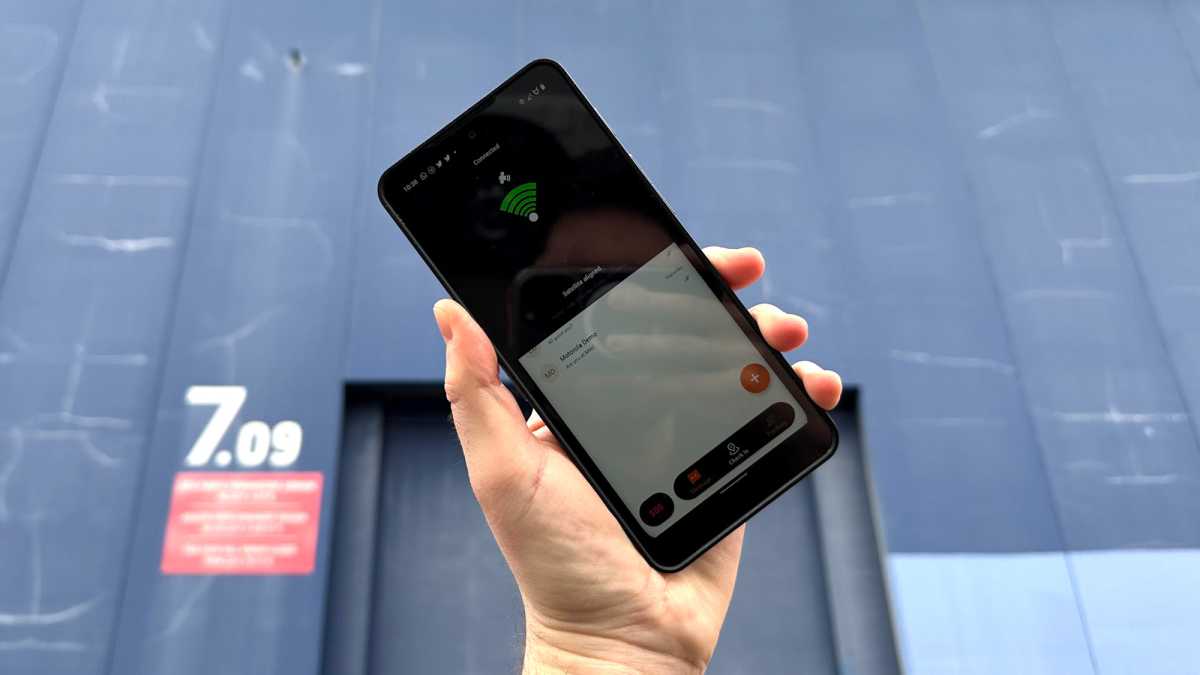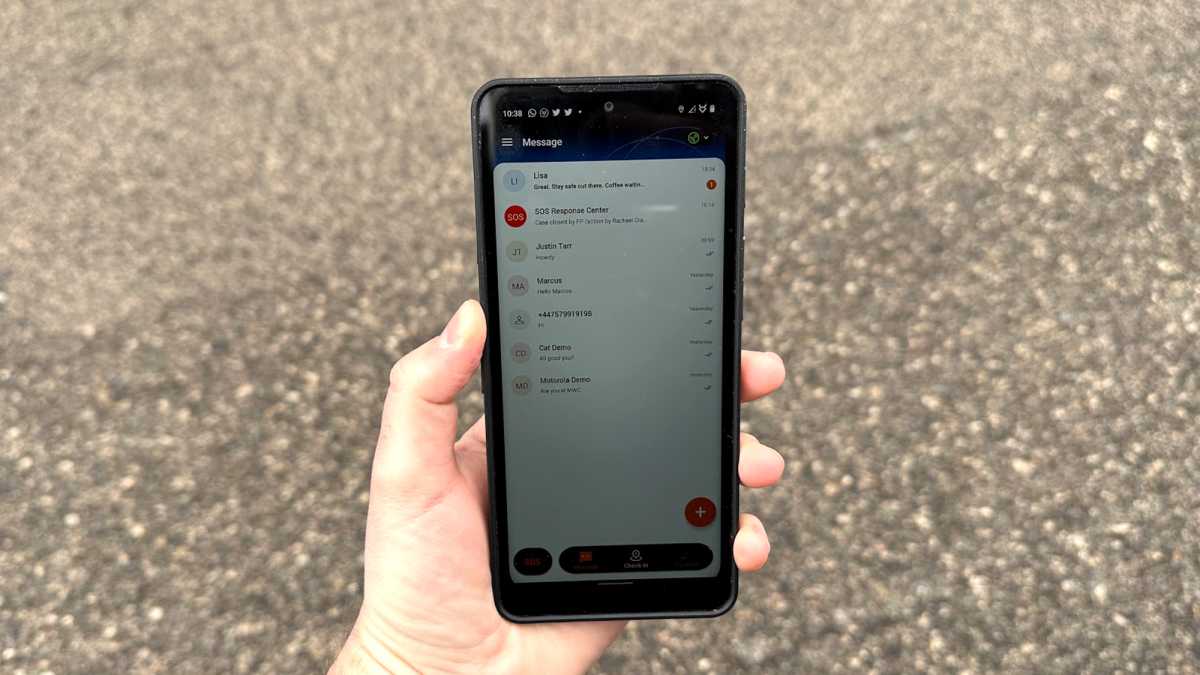On a cloudy day at Mobile World Congress last week in Barcelona, I went outside from one of the big conference halls into daylight, pointed a phone at the sky, and saw a message being sent via satellite – no mobile network needed.
All you need is an inexpensive Bluetooth device and service plan.
Why is that a big deal? As always, context matters.
You might have a great SIM deal that gets you unlimited calls, texts, and data, but all that is no use if you don’t have any signal.
Many technology companies are trying to find ways to add satellite communications into smartphones because there are times when we find ourselves with no cellular coverage and can’t send or receive messages or calls.
You might find yourself in an emergency but without a mobile signal and wish your phone could use satellite messaging, but practically no phones have it built in. Apple added an emergency messaging SOS feature to its iPhone 14 phones, but it’s limited to a few countries and pricing is unannounced (it’s free for two years initially).
Qualcomm, the US chipset provider for many Android manufacturers, is also promoting Snapdragon Satellite, its tech that its customers will be able to add to future, premium smartphones.
But while Apple’s emergency via satellite lets you message with emergency services, the usual back-and-forth texting with people we are used to with regular SMS, WhatsApp, iMessage, Telegram, or any other messaging app is still not what these services are designed for.
You might think that if these mega-corps haven’t got satellite messaging to mass market yet, then a small British company probably hasn’t either. But it has.
Bullitt Group, based in Reading, England, has a global satellite messaging service that lets you send and receive messages to and from anyone with a mobile number anywhere in the world, and it’s live right now in Europe and North America for consumers and business buyers. It’s designed for emergency use, but can technically be used for any purpose.
Bullitt has been making phones for about 15 years as a licensee where it builds the devices but sells them with recognisable brand names such as Motorola to make them more appealing to buyers.
Standing with me under those cloudy skies was Bullitt Group’s head of satellite marketing, Phil Wicks. He was armed with the new CAT S75, a $599/£599 Android phone with satellite connectivity built in. Using a service plan and the Bullitt messaging app, Phil sent several messages that I saw sent and responded to live, with no cellular network involved.

Henry Burrell / Foundry
Wicks said that until now satellite communications have been achieved via large expensive devices not designed for consumers.
“There’s no reason why it should be as expensive as it has been,” Wicks said. “We’re just showing it can be cheap.”
The S75 can send messages or ping live locations to emergency contacts, and you can also use a triaging service via multiple choice questions with emergency services globally should you be unable to compose a message.
If you don’t fancy a rugged, bulky CAT phone then you can soon instead buy a $99/£99/€119 Motorola Defy Satellite Link, a Bluetooth dongle that adds satellite comms to any Android phone or iPhone. It is powered by the MT6825 chipset from MediaTek, one of Qualcomm’s closest market competitors. We gave the Defy a Best of MWC 2023 award for the sheer affordability and peace of mind it could add to your life (or backpack).
“We’re trying to make sure we can put that into a form factor that’s much more user friendly, but also that service plans are realistic … it’s about making satellite available to people.”
You can send a message using the Bullitt app thanks to the company’s use of two constellations of geostationary satellites from firms Inmarsat and EchoStar.
Geostationary satellites are those that orbit the Earth at the same speed as the Earth rotates, effectively always maintaining their same positions in the sky. These constellations are 22,300 miles above the Earth and positioned close to the equator.
The person sending the message needs the Bullitt service plan but the receiver does not. You can buy 30 messages on a monthly $4.99/£4.99 plan.
It means you could buy the Defy dongle and a service plan with 30 two-way messages per month for one year for $149/£149/€169.
The service, Bullitt Satellite Connect, is live in Europe and North America but Wicks said it will be live in Latin America, South Africa, Australia and NZ, and then “everywhere else” by the end of 2023.

Henry Burrell / Foundry
“There’s no technical reason why we can’t have global global coverage but there is some geopolitical reasons. Saudi Arabia, Iran, China, Russia, get a little bit baity about people using satellites without them knowing,” he said.
The plans remain relatively cheap because the service is plain text messaging. Sure, it’s not as cheap as sending messages on your normal SIM plan, but don’t forget you are bypassing the entire mobile network and using a technology that is very new and isn’t otherwise available to consumers. Plus, what price do you put on safety if you’re heading out on an adventure where there’s likely to be no mobile coverage?
“We use the narrowband IoT channel, which uses small amounts of data. So, it’s all about trying to keep that cost down, and use infrastructure that’s already there.”
Though Bullitt’s main customers are businesses such as vehicle recovery companies, security firms, agricultural buyers, emergency services, first responders, and those in areas with no power, the affordability and availability of the Motorola Defy makes a compelling case for a back-up satellite device for emergencies being sold down at your local outdoor store, or even supermarket.
Tech giants might have us believe satellite messaging is rare or expensive, but that could be because they don’t want to over signal to the mobile operators that we might not need mobile networks in future.
Those manufacturer relationships with operators are paramount. It turns out Bullitt has no such concerns.
Wicks said some operators are panicking, but the larger ones are investing in the technology themselves. His company simply feels it is ahead of the curve.
“We’re a relatively small company but just because we’re slightly more dynamic and flexible, we’ve worked this out quite quickly. Big corporations just take time to sort things out.”


